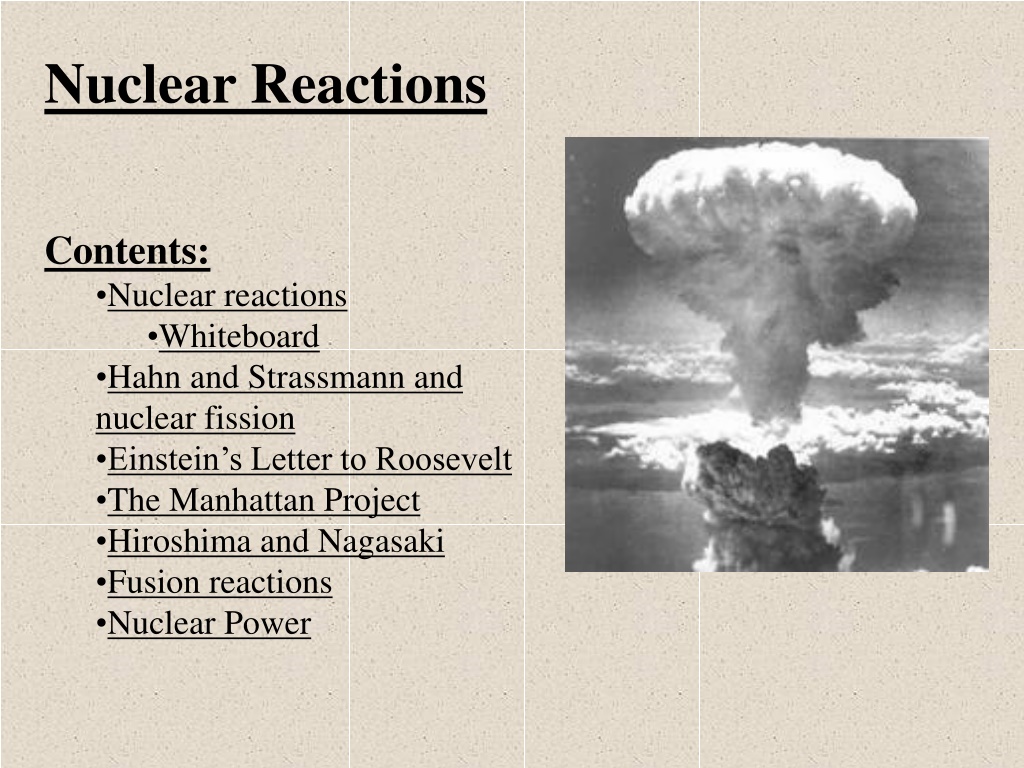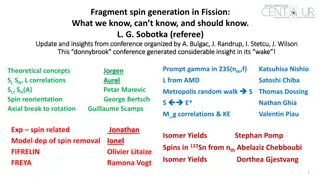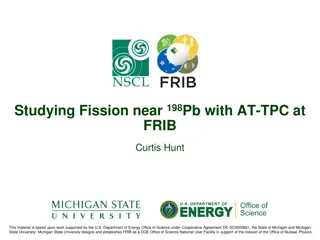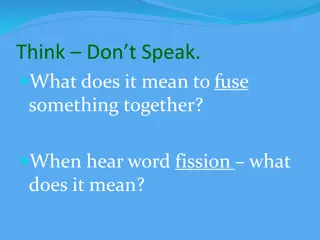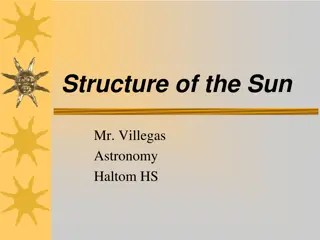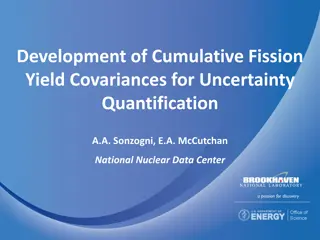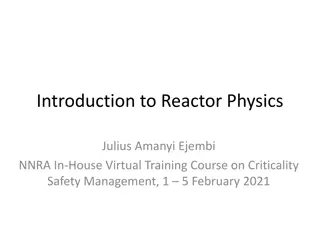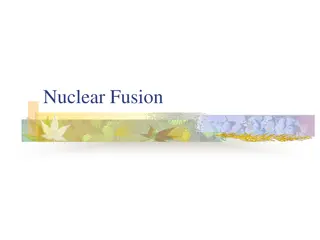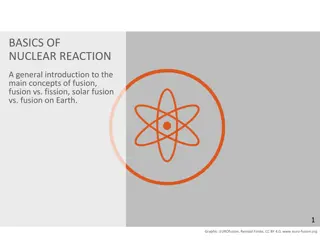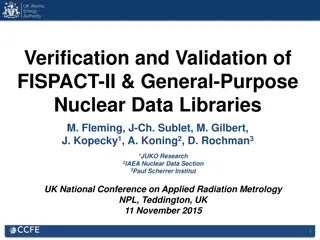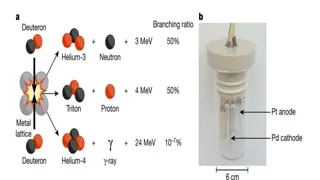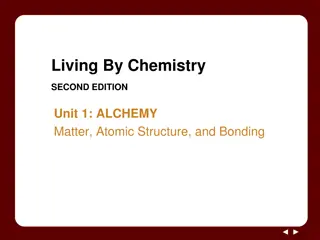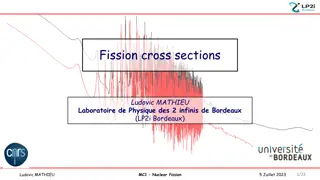Understanding Nuclear Reactions: Fission, Fusion, and Energy Release
This content covers various aspects of nuclear reactions, including nuclear fission, fusion reactions, the Manhattan Project, and examples of reactions involving different particles and elements. It explains concepts like exoergic and endoergic reactions, conservation of charge and nucleon number, and how particle accelerators provide energy. The examples provided help illustrate the processes involved in nuclear reactions.
Download Presentation

Please find below an Image/Link to download the presentation.
The content on the website is provided AS IS for your information and personal use only. It may not be sold, licensed, or shared on other websites without obtaining consent from the author. Download presentation by click this link. If you encounter any issues during the download, it is possible that the publisher has removed the file from their server.
E N D
Presentation Transcript
Nuclear Reactions Contents: Nuclear reactions Whiteboard Hahn and Strassmann and nuclear fission Einstein s Letter to Roosevelt The Manhattan Project Hiroshima and Nagasaki Fusion reactions Nuclear Power
Nuclear reactions 42He + 147N ---> 178O + 11H Charge and nucleon number are conserved Can be written as follows: 147N( , p)178O Initial Nucleus(bombarding particle,emitted particle)Final Nucleus = 42He, p = 11H, d(deuterium) = 21H, t(tritium) = 31H, 10n = neutron, 00 = gamma Left side mass vs right side mass Exoergic - releases energy (+Q) Endoergic - requires energy (-Q) Particle accelerators provide energy for endoergic
Nuclear reactions - example What s the initial nucleus? ??? + n ---> p + 146C ???(n, p)146C ??XX + 10n ---> 11p + 146C 147N
Whiteboards: Nuclear Reactions 1 | 2 | 3 | 4
13756Ba(n, )??? (hint) 00 13756Ba + 10n ---> 00 + ??XX 13856Ba 13856Ba
13756Ba(n, ?)13755Cs 13756Ba + 10n ---> ?? XX + 13755Cs 11p p
21H(d, ?)42He (1 hint) 21d 21H + 21H ---> ?? XX + 42He 00
19779Au( , d)??? (2 hints) 42 21 d 19779Au + 42 ---> 21 d + ??XX 19980Hg 19980Hg
94Be(?, t)84Be(1 hint) 31 t 94Be + ??XX ---> 31 t + 84Be 21d 21d
Is this reaction exoergic or endoergic? What energy does it give off? (Known as the Q value) (+Q = Exo, -Q = Endo) 19779Au( , d) 19980Hg 19779Au =196.966543 = He = 4.002602 total = 200.969145 19980Hg =198.968253 d = 2H = 2.014102 total = 200.982355 It gains 0.01321 u of mass, so it requires (0.01321)(931.5) = 12.31 MeV of energy This is endoergic Q = -12.30 MeV
Try this reaction - is it endo or exo, and how much? 4019K(p, n) 4020Ca 4019K = 39.964000 p = H = 1.007825 4020Ca = 39.962591 n = 1.008665 It loses 0.00057 u of mass, so it gives off (0.00057)(931.5) = .53 MeV of energy This is exoergic Q = +0.53 MeV
Hahn and Strassmanns discovery Fermi discovers that neutrons are the way to go, and discovers many nuclear reactions In 1938, Otto Hahn and Fritz Strassmann discover that Uranium will split in half: n + 23592U ---> 14156Ba + 9236Kr + ( )n (typical) The reaction releases 200 MeV The neutrons released could trigger further fission
Lets find the Q-Value: n = 10n = 1.008665 u U-235 = 235.043923 u Ba-141 = 140.914406 u Kr-92 = 91.926153 u n + 23592U ---> 14156Ba + 9236Kr + ( )n How many neutrons does it release? What is the Q-Value? (+173.3 MeV) What is the energy density in J/kg if this is the only reaction that occurs? (7.112x1013 J/kg 7.112x107 MJ/kg)
Hahn and Strassmanns discovery Fermi discovers that neutrons are the way to go, and discovers many nuclear reactions In 1938, Otto Hahn and Fritz Strassmann discover that Uranium will split in half: n + 23592U ---> 14156Ba + 9236Kr + 3n (typical) The reaction releases 173.3 MeV In general on the order of 200 MeV The neutrons released could trigger further fission
Hahn and Strassmanns discovery Scientists begin to realize that a chain reaction could lead to a very powerful explosion Demo - critical mass
Einsteins Letter to Roosevelt In Summer 1939, US has no atomic energy program Hitler has halted sales of Czech Uranium Hitler classifies all nuclear research Hungarian Physicist Leo Szilard (and many others) worried Cannot convince Fermi Turns to Einstein Einstein returns from vacation, and writes a letter to Roosevelt
Einstein is a pacifist Einstein fears Hitler
US starts 1 day before Pearl Harbor bombing. (2 1/2 years later)
The Manhattan Project Started in 1942 in Los Alamos NM Unprecedented rush to make a bomb Basic concept - Combining two sub critical masses: Explosive Tube Uranium 235 Separating U 235 from 238 by gaseous diffusion at Oak Ridge Feynman and the chemical engineer
Hiroshima and Nagasaki Near the end of WWII, the US had been bombing nearly every major city in Japan. For some reason, Hiroshima and Nagasaki had been spared. They had become refugee centers for those displaced by bombing elsewhere. At 8:15, August 6, 1945 The U.S. detonated a Uranium Fission bomb 1,900 feet above the city of Hiroshima. TOC
People were killed, and all the people who knew them as well
3 days later, we dropped another bomb on the city of Nagasaki, killing 74,000 people,
Nagasakis rugged topography protected larger parts of the city from the direct blast.
In total, the nuclear bombs the US dropped on Japan killed more than 350,000 people, the vast majority of them non-combatants Emperor Hirohito surrendered on September 2 Hindsight vs. foresight
Nuclear Fusion - joining of Nuclei Fusion powers the sun: Energy comes primarily from the Proton- Proton cycle: 1H + 1H = 2H + e++ 1H + 2H = 3He + 3He + 3He = 4He + 1H + 1H (requires heat and pressure)
Nuclear Fusion - joining of Nuclei Helium can also fuse: 4He + 4He = 8Be + 4He + 8Be = 12C + Carbon can fuse as well: 12C + 12C = 24Mg + 16O + 16O = 28Si + 4He Fusion can keep happening until you reach the mass of Iron or Nickel (In super giant stars)
The curve of binding energy Binding energy per nucleon Going to more tightly bound releases energy A U235 bomb is technically difficult A Pu bomb is easy - not efficient? Most tightly bound Fission releases energy Fusion releases energy
Nuclear power Closed loop design/moderator No greenhouse gases emitted/High Energy density What do you do with the waste?
Cherynobl Kid of Speed http://www.kiddofspeed.com/
